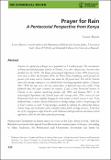| dc.description.abstract | Nairobi, the capital city of Kenya, has a population of 3.5 million people. The concentration
of Pentecostal and charismatic churches in Nairobi, as in other African cities, has more than
doubled since the 1970s. The Kenya meteorological department in June 2016 forecast poor
short rains in 2016. By December 2016, the Thika Dam (Ndakaini), which provides 85
percent of the water used in Nairobi, was below the 50 percent level. This led the Nairobi
water and sewerage company to issue detailed water-rationing programmes effective 1 January
2017. With dry taps across the city, actual effects of depressed rains were visible. Using
fieldwork data, this paper examines the response, if any, of three Pentecostal churches in
Nairobi in two separate month-long periods, July 2016 and January 2017, to the
meteorological department and Nairobi water and sewerage alerts. Three services for each
Pentecostal church were sampled, bringing the total number of church services to nine. From
fieldwork data, a vibrant African Pentecostal eco-theology emerges, which is the greening of all
of God’s creation on earth. Using typologies available for defining the relationship between
human beings and nonhuman nature identified within public theology discourse, I find that
two of the congregations align themselves with utilitarian anthropocentrism and nature-centred
approaches, while the other defies plausible positioning | en_US |

